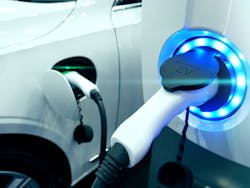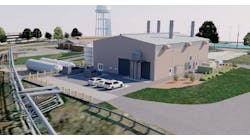US car dealerships are finding they need to upgrade their electrical infrastructure — and fast — given that more than half of their sales are expected to come from electric vehicles (EVs) before the decade is out.
Sean Gouda, executive vice president of Future Energy, outlined what car dealerships face as their electric demand grows from charging stations in a speech last week at the NADA Show 2022 in Las Vegas, Nevada.
Gouda did not mention microgrids, but he inadvertently made the case for them as he described a coming rush for more electric service to supply charging stations as well as likely delays as utilities try to meet that demand.
There is “only so much subscription” available on distribution lines right now, he said. Your dealership won’t be alone in seeking more service. Other nearby businesses will be as well, not only for EV charging but also for building electrification, he said. Utilities may need to make upgrades, which could take years.
“They’re using more and more kilowatts on that system. And utilities will say, we’re fully subscribed. We have to build a new line or we have to change the way this line is currently configured. That’s gonna take time and resources — and I will tell you it’s coming,” he said.
He also noted that electrification could open up new business models for dealerships. For example, they may be able to offer public charging.
Microgrids offer on-site energy to help diminish the need for utility power and they provide a way for the dealerships to ease electricity costs by managing electric load more efficiently and selling services from the microgrid to the electric grid.
Microgrids also offer car dealerships the ability to keep the electricity flowing when a grid outage occurs. Power outages will become more crippling for car dealerships as they swap out more of their gasoline-powered cars for electric vehicles.
A Toyota dealership in Greeley, Colorado, has already made the move. Ehrlich Toyota was losing business because of prolonged power outages during operating hours.
“You wouldn’t think a car dealership would be impacted by power outages, but the owner had 20 technicians working on cars in the back shop. If the power went out, they were still being paid, and all cars were either stuck in a loft or behind a garage door, said Mike Murray, COO of Ageto Energy, in an article about the project published by Microgrid Knowledge.
Before the microgrid was installed, the Toyota dealership experienced two to four outages a year.
The company installed a solar plus storage microgrid with an Ageto Renewable Controller. Solar carports added the extra advantage of protecting vehicles from damaging hail storms that increased insurance deductibles.
Gouda noted that in addition to cars, electric buses will be placing new demand on electric supply. The energy needed to charge the battery of one bus could power 100 houses, he said.
“They’re gonna have a depot of 50 of those. How are they gonna feed that?” he asked.
Gouda described the power as coming from the bulk electric system. Like car dealerships, some bus depots are not relying solely on bulk power, but are turning to microgrids.
Montgomery County, Maryland, offers an example. The county is building a 5.6 MW microgrid with distributed energy generation, energy storage and over 2 MW of charging capacity at its Brookville bus depot.
AlphaStruxure, a joint venture between Schneider Electric and the Carlyle Group, designed — and will build and deliver — the project for the county, using an energy-as-a-service model that doesn’t require the county to make upfront payments.
Gouda said the bottom line is that car dealerships need to start planning now for the electric capacity and interconnection issues they may face.
“It’s really important to get out ahead of this as a dealer, or any type of developer, that’s getting ready to put this type of infrastructure in because you need to coordinate with that utility to make sure that the supply is there for your business,” he said.
Track news about microgrids for EV charging. Subscribe to the free Microgrid Knowledge Newsletter.







